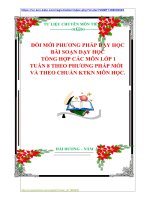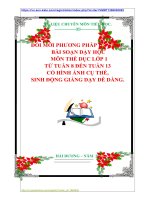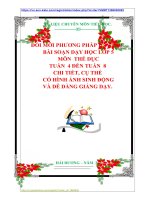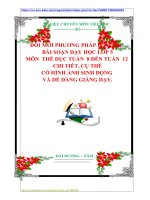Ta6 tuan 8 p22,23,24
Bạn đang xem bản rút gọn của tài liệu. Xem và tải ngay bản đầy đủ của tài liệu tại đây (191.45 KB, 17 trang )
<span class="text_page_counter">Trang 1</span><div class="page_container" data-page="1">
<b><small>QUANG TAM LOWER SECONDARY SCHOOL </small></b>
<i>Date of planning: October 23<small>rd</small>, 2022 </i> <b>Week: 08</b>
- Review the vocabulary and grammar of Unit 3
- Apply what they have learnt (vocabulary and grammar) into practice through a project
<b>2. Core competence</b>
- Develop communication skills and creativity
- Be collaborative and supportive in pair work and team work - Actively join in class activities
<b>3. Personal qualities</b>
- Develop self-study skills
<b>II. Materials </b>
- Grade 6 textbook, Unit 3, Looking back and project - Computer connected to the internet
- Projector/ TV/, colours and pens, worksheets to the topic and lead in the next part of the lesson.
<i><b>* Brainstorming</b></i>
- Teacher divides the board, and divides the class into 2 big groups. - Each group will be assigned a
category: APPEARANCE & PERSONALITIES
- Teacher asks students to brainstorm all adjectives related to people’s appearance and personalities.
- The group having the most suitable answers is the winner.
<i><b>Suggested answers:</b></i>
Group work
5 mins
</div><span class="text_page_counter">Trang 2</span><div class="page_container" data-page="2"><b><small>QUANG TAM LOWER SECONDARY SCHOOL </small></b>
- Appearance: tall, short, beautiful,
<b>Task 1: Choose the best options to complete the sentences. (Ex. 1, p. 34)</b>
- Teacher encourages students to complete the task individually. - Students exchange their textbook to
discuss the reasons why they are choosing the appropriate adjectives. - Teacher gives feedback as a class
- Teacher asks students to choose the number and answer the
questions quickly in 3 seconds. - If students choose the lucky number,
they don’t have to answer.
1. Who has long hair in your class? 2. Who has a small nose?
3. Who has a round face?
4. Does the classmate next to you have long hair?
</div><span class="text_page_counter">Trang 3</span><div class="page_container" data-page="3"><b><small>QUANG TAM LOWER SECONDARY SCHOOL </small></b>
To help students revise present tenses in context
5. Does the classmate next to you have big eyes?
6. LUCKY NUMBER
<b>Task 3: Put the verbs in the </b>
<b>brackets in correct forms. (Ex. 3-4, p. 34)</b>
- Teacher has students complete the task individually.
- Students exchange their textbooks to discuss the reasons about their choices.
- Students should record their original answers to guide their
1. are running 2. are talking 3. are not talking / aren’t talking 4. are drawing 5. is not teaching /
isn’t teaching
Ex. 4: 1. are you doing; am writing / ’m writing
2. cycles; don’t cycle; walk
3. Is he doing; is reading / ’s reading
- Teacher sets the context and asks
students to bring a photo of his/her friend to class.
mins
</div><span class="text_page_counter">Trang 4</span><div class="page_container" data-page="4"><b><small>QUANG TAM LOWER SECONDARY SCHOOL </small></b>
practice through a project.
- Teacher asks students to write a draft (using the clues)
- Teacher checks and sets time for students to make a year-book page.
Teacher asks students to talk about what they have learnt in the lesson.
Prepare for the next lesson: Read Review 1.
</div><span class="text_page_counter">Trang 5</span><div class="page_container" data-page="5"><b><small>QUANG TAM LOWER SECONDARY SCHOOL </small></b>
Lesson 1: Getting started – Lost in the old town! (Period 23)
<b>I. Objectives</b>
By the end of this lesson, students will be able to:
<b>1. Knowledge</b>
<i>- Get an overview about the topic My neighbourhood</i>
- Use vocabulary to talk about different places and show directions to these ones
<b>2. Core competence</b>
- Develop communication skills and creativity
- Be collaborative and supportive in pair work and team work - Actively join in class activities
<b>3. Personal qualities</b>
- Develop self-study skills
<b>II. Materials </b>
- Grade 6 textbook, Unit 4, Getting started - Computer connected to the internet. - Projector/ TV/ pictures and cards
the area that you are in or the area near a particular place
/ˈneɪbəhʊd/ khu vực lân cận 2. to be/ get lost when you cannot find the way
or don’t know where you are in a neighbourhood
/tuˈbɪ/ /get lɒst/ đi lạc
<b>Procedure</b>
</div><span class="text_page_counter">Trang 6</span><div class="page_container" data-page="6"><b><small>QUANG TAM LOWER SECONDARY SCHOOL </small></b>
up context for the
listening and reading text.
- Teacher shows some images of Hoi An on the screen and asks students some open questions: “Do you know
“Have you ever been to Hoi An?” “Do you remember anything special in
Hoi An?”
To lead in the topic
<i>Lost in the old town.</i>
Today we are going to travel around Hoi An; before we start the lesson, let’s get some vocabulary first.
Teacher sets the context for the listening and reading “Today we’ll meet 3 students. They are Nick, Phong and Khang. Let’s look at the picture and answer some questions:
<i>1.What are Nick, Phong and Khang doing?</i>
<i>2.Where are they? </i>
<i>3.What might be happening to them?</i>
<i>4.Have you ever got lost?</i>
<i>5.How did you feel? What did you</i>
</div><span class="text_page_counter">Trang 7</span><div class="page_container" data-page="7"><b><small>QUANG TAM LOWER SECONDARY SCHOOL </small></b>
To help students know how to use
<i>Let’s and Shall to </i>
make suggestions.
their experiences of being lost but teacher doesn’t have to confirm the answers right or wrong.
- Teacher asks student to get some predictions of the orderings.
- Teacher plays the recording and asks the students to work independently
<i>to put a-e in order of what happens </i>
in the conservation.
- Students listen and read and then do the ordering.
- Teacher invites some pairs of students to read the dialogue aloud.
<i><b>Answer key: </b></i>
1. b 2. c 3. d 4. e 5. d
<b>Task 2: How to make suggestions.</b>
Teacher asks students to look at the photo and the text in order to find the answers.
- Students work independently. - Teacher allows students to share
their answers before discussing as a class.
<i><b>Answer key:</b></i>
1. Let’s go to Chua Cau! 2. Shall we go there first?
3. First, cross the road, and then turn left.
4. Fine, let’s go. 5.Let’s ask her.
<i><b>Model sentences: Making </b></i>
</div><span class="text_page_counter">Trang 8</span><div class="page_container" data-page="8"><b><small>QUANG TAM LOWER SECONDARY SCHOOL </small></b>
- Where do Phong, Nick and Khang go first? Who suggests going there? What does he say? Do Nick and Khang agree? What do they say? Teacher writes model sentences: - Shall we go there first?
- OK, sure. * Check:
- Use: When do you ask these
questions? (when we want to make
- Ask students to work individually to find and underline the phrases used to give directions in the
conversation.
Teacher may move around the class to check if students do exactly what is required and offer help when needed. - Have students quickly match each
direction with the diagram. Check
T-Ss
</div><span class="text_page_counter">Trang 9</span><div class="page_container" data-page="9"><b><small>QUANG TAM LOWER SECONDARY SCHOOL </small></b>
their answers as a class. If students do not understand the phrases, use the diagrams to work the
meaning out from the context. If it is a weaker class, ask for translation to make sure they understand. With a stronger class, teacher may wish to ask some additional questions, e.g. Can you tell me the way to the post office near here? etc.
<b>Game: Find places</b>
- Demonstrate the game with a more able student.
- Ask students to play the game in pairs. In a weaker class, work together with students first: asking about one or two different places on the map and eliciting the answers. Then when they know exactly what to do, ask them to work in pairs. Teacher may go around to
observe and offer help if necessary. - Invite some pairs to perform in front
of the class. This activity can be organized as a competition game. The class is divided into teams A and B. Team A gives directions and Team B guesses the place.
If their guess is correct, they get one
</div><span class="text_page_counter">Trang 10</span><div class="page_container" data-page="10"><b><small>QUANG TAM LOWER SECONDARY SCHOOL </small></b>
point. Then change roles. The group with more points is the winner.
If there is still enough time teacher can give students one more map-to-go.
- Ask one or two students to tell the class what they have learnt.
- Ask students to say aloud some words they remember from the lesson. If there is an overhead
projector in the classroom, show the dialogue, highlight the key words related to the topic.
vocabularies for the next lesson: A closer look 1.
Go to the internet and search for the places in the neighbourhood.
T-Ss 1 min
</div><span class="text_page_counter">Trang 11</span><div class="page_container" data-page="11"><b><small>QUANG TAM LOWER SECONDARY SCHOOL </small></b>
<i>Date of planning: October 23<small>rd</small>, 2022 </i> <b>Week: 08</b>
+ <i>the lexical items related to the topic My neighbourhood</i>
+ vocabulary and structures to talk about and describe places in a neighbourhood
- Identify and pronounce the sounds /ɪ/ and /i:/
<b>2. Core competence</b>
- Develop communication skills
- Be collaborative and supportive in pair work and team work - Actively join in class activities
<b>3. Personal qualities</b>
- Be responsible and hard working - Develop self-study skills
<b>II. Materials </b>
- Grade 6 textbook, Unit 4, A closer look 1 - Computer connected to the internet
- TV/ Projector/ Pictures/ Cards - sachmem.vn
<b>Language analysis </b>
<b>equivalent </b>
1. square (n) an open area in a town, usually with four sides, surrounded by buildings
/skweə/ quảng trường
2. cathedral (n) the main church of a district, under the care of a bishop
/kəˈθiːdrəl/iːdrəl/ thánh đường 3. railway
station (n)
a place with one or more buildings and platforms where trains stop for
/ˈreɪlweɪ ˈsteɪʃən/
nhà ga xe lửa
</div><span class="text_page_counter">Trang 12</span><div class="page_container" data-page="12"><b><small>QUANG TAM LOWER SECONDARY SCHOOL </small></b>
people to get on or off
quiet and calm; not worried or upset in any way
/ˈpiːsfl/ thanh bình 6. modern (adj) new and intended to be different
from traditional styles
/ˈmɑːdərn/ hiện đại 7. boring (adj) not interesting; making you feel
tired and impatient
- Teacher divides students into 4 groups and models how to play this game. - Teacher shows one by one a mixed up
set of letters and students have to unscramble the letters to find the correct word.
- Teacher asks students to raise hands to give the correct names and spelling of the places.
- The fastest group raising their hands will get the chance to answer first. - Teacher gives 10 points for the group
that gives the correct answers. - The group getting the highest points
will be the winner.
</div><span class="text_page_counter">Trang 13</span><div class="page_container" data-page="13"><b><small>QUANG TAM LOWER SECONDARY SCHOOL </small></b>
Teacher leads students into the lesson by telling them that
“In today lesson, we are going to learn more words to name and describe places in a neighbourhood and learn how to pronounce correctly two sounds /i/ and /i:/.”
Teacher introduces the vocabulary by: - providing the synonyms or antonyms 3. railway station (n) [picture] 4. crowded (adj) [explanation] 5. peaceful (adj) [synonym] - quiet 6. modern (adj) [antonym] -
</div><span class="text_page_counter">Trang 14</span><div class="page_container" data-page="14"><b><small>QUANG TAM LOWER SECONDARY SCHOOL </small></b>
<b>Task 1: Match the places below with the pictures. Then listen, check and repeat the words. </b>
- Teacher asks students to match the places with the pictures.
- Students do the task.
- Teacher asks students to swap their books and mark in pairs.
- Teacher plays the recording (Track 24) for students to listen and check their partner’s answers.
- Teacher plays the recording again with a pause after each item and asks students to repeat the words/ phrases chorally and individually.
<i><b>Answer key:</b></i>
1. C 2. E 3. D 4. A 5. B
<b>Task 2: Work in pairs. Ask and answer questions about where you live.</b>
- Teacher asks students to work in pairs to ask and answer questions about where they live. Remind them that they can use the places in one or any places they want to ask.
- Teacher calls some pairs to practise in front of the class.
- Teacher gives feedback and corrections (if necessary).
<b>Task 3: Work in groups. Ask and answer about your neighbourhood. </b>
</div><span class="text_page_counter">Trang 15</span><div class="page_container" data-page="15"><b><small>QUANG TAM LOWER SECONDARY SCHOOL </small></b>
- Teacher models this activity with a more able student and remind students that they can use adjectives in the box or other adjectives they know to talk about their village, town, city.
- Students work with their partners.
- Teacher calls some pairs to practise in front of class.
- Teacher may ask other students to give comments.
- Teacher introduces 2 sounds /i/ and /i:/ to students and lets them watch a video about how to pronounce these two sounds and asks them to
identify which sound is longer and which one is shorter.
<b>- Teacher asks students to give some </b>
words they know
containing these sounds.
<i><b>Suggested answers:</b></i>
- /i/: chip, tin, ship, …
<b>- /i:/: cheap, teen, sheep, …</b>
<b>Task 4: Listen and repeat the words. Pay attention to the sounds /i/ and /i:/.</b>
- Teacher asks students to T-Ss
5 mins
</div><span class="text_page_counter">Trang 16</span><div class="page_container" data-page="16"><b><small>QUANG TAM LOWER SECONDARY SCHOOL </small></b>
To help students practise the sounds /i/ and /i:/ in
practise the sounds /i/ and /i/ together. - Teacher plays the recording and ask
students to repeat.
- Teacher gets students to work in pairs and put the words in the correct
column while they listen and call some pairs to write their answers on the board before checking their answers with the whole class.
<i><b>Answer key:</b></i>
noisy, exciting, expensive, friendly /i:/
clean, peaceful, convenient, cheap
<b>Task 5: Listen and practise the chant.Notice the sounds /i/ and /i:/.</b>
- Teacher asks students to listen while teacher plays the recording.
- Teacher plays the recording again and ask students to chant along.
- Teacher provides further practice by dividing the class into 2 groups. - Teacher has groups sing alternate chance to apply and challenge what they have learnt with more difficult task.
<i><b>Game: Tongue Twister</b></i>
<b>- Teacher shows the Tongue Twisters </b>
and asks students to practise in groups
</div><span class="text_page_counter">Trang 17</span><div class="page_container" data-page="17"><b><small>QUANG TAM LOWER SECONDARY SCHOOL </small></b>
<i>the sea. He says it keeps him fit.2. He thinks he's slick in his sleek </i>
<i>wheels meeting and greeting the elite.</i>
- Students practise in groups.
- Teacher calls the representative from each group to say the sentences in front of the class.
<i>- Teacher asks each group to vote for </i>
the group which has the best what students have learnt in the lesson.
Teacher asks students to talk about what they have learnt in the lesson.
Find 5 more words with the sound /i/ and 5 more words with the sound /i:/. Write them down and practise
pronouncing the words.
T-Ss 1 min
</div>








